Abstract
OBJECTIVES--To determine the frequency and mode of inheritance of familial dilated cardiomyopathy in the United Kingdom. BACKGROUND--Two recent prospective studies have suggested that familial forms of dilated cardiomyopathy are common but have been limited by selective screening methods, inadequate diagnostic criteria, and low rates of ascertainment. METHODS--Prospective screening study of 236 relatives from 40 families of patients with dilated cardiomyopathy. Screening consisted of clinical examination, 12 lead electrocardiogram, and two-dimensional Doppler echocardiography. Relatives with systemic hypertension and other cardiac diseases were excluded from the study. All echocardiograms were performed by an experienced echocardiographer who was blinded to clinical information. Relatives were classified as having dilated cardiomyopathy, left ventricular enlargement (method of Henry), depressed fractional shortening, or as being normal. Relatives with abnormal investigations underwent further evaluation as appropriate. RESULTS--Twenty five cases of dilated cardiomyopathy were identified and came from 10 (25%) of the 40 families screened. Pedigree analysis was most consistent with autosomal dominant inheritance and variable penetrance (65-95%). Of the remaining apparently healthy relatives, 37 (18%) were found to have left ventricular enlargement and nine (4%) depressed fractional shortening; these values were significantly higher than those observed in 239 healthy controls (24 (10%), P = 0.02 and one (0.4%), P = 0.01, respectively). CONCLUSIONS--Patients with dilated cardiomyopathy commonly have an affected family member and a high proportion of apparently healthy relatives with minor echocardiographic abnormalities. Segregation analysis suggests that familial dilated cardiomyopathy is the result of the transmission of a rare autosomal dominant gene. Further studies are currently underway to characterise the molecular basis of familial dilated cardiomyopathy and identify early disease within these families.
Full text
PDF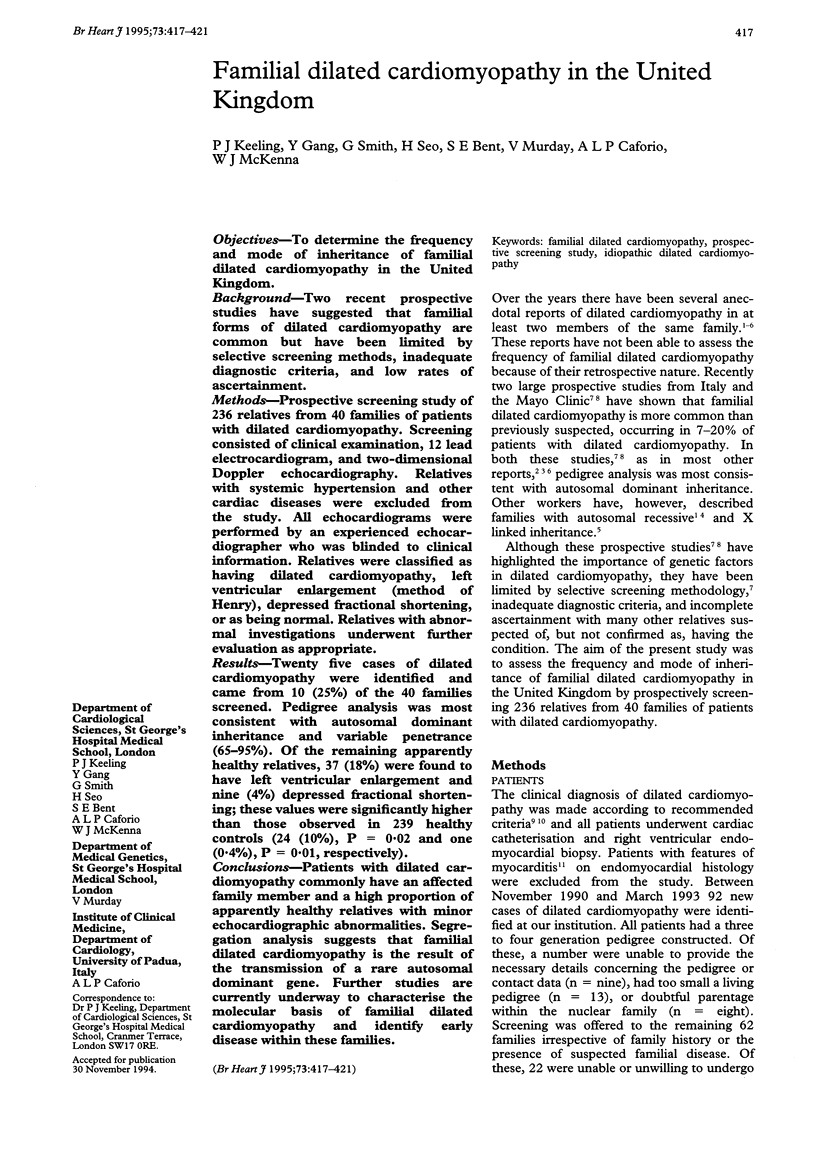
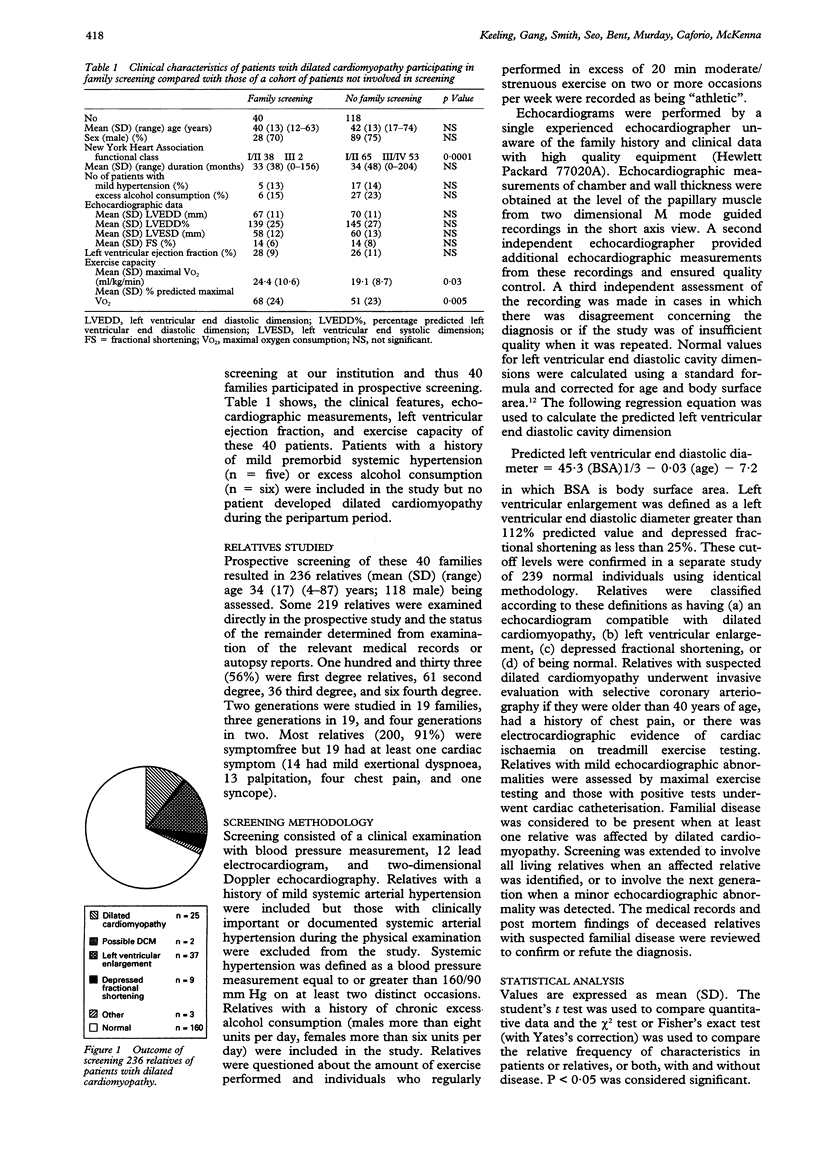
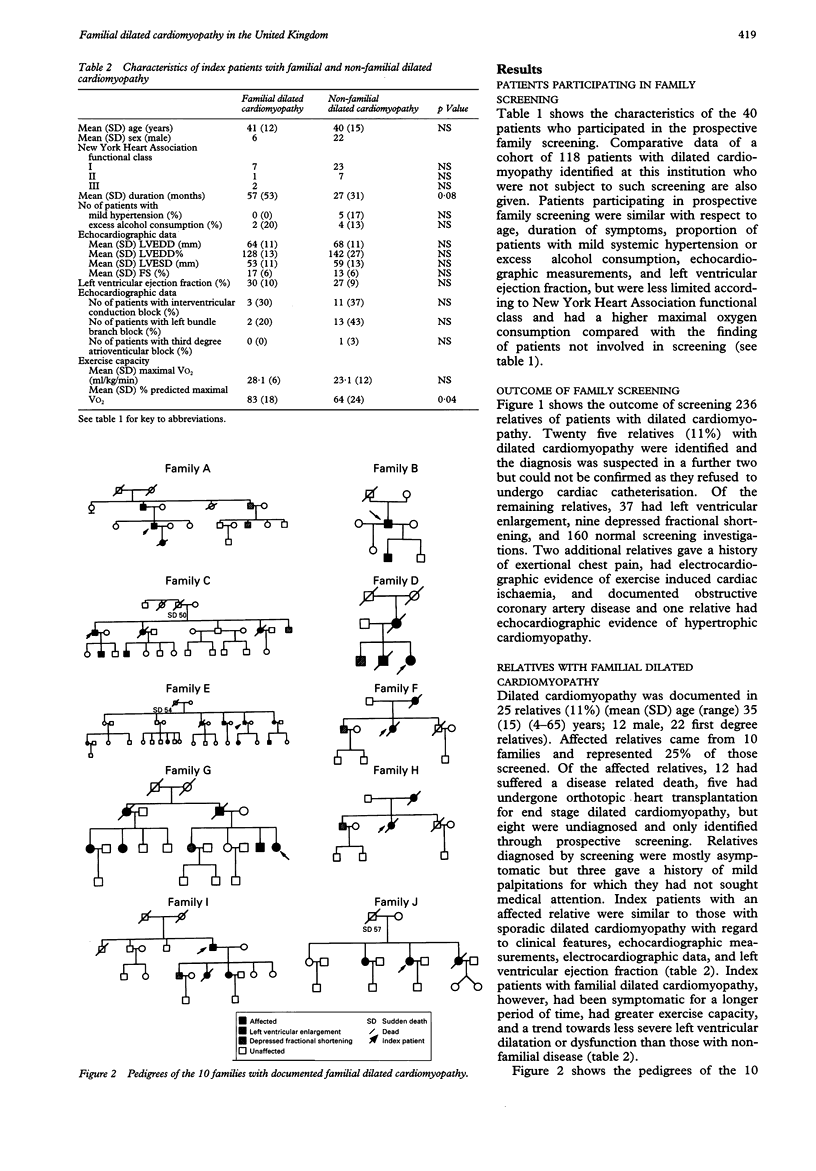
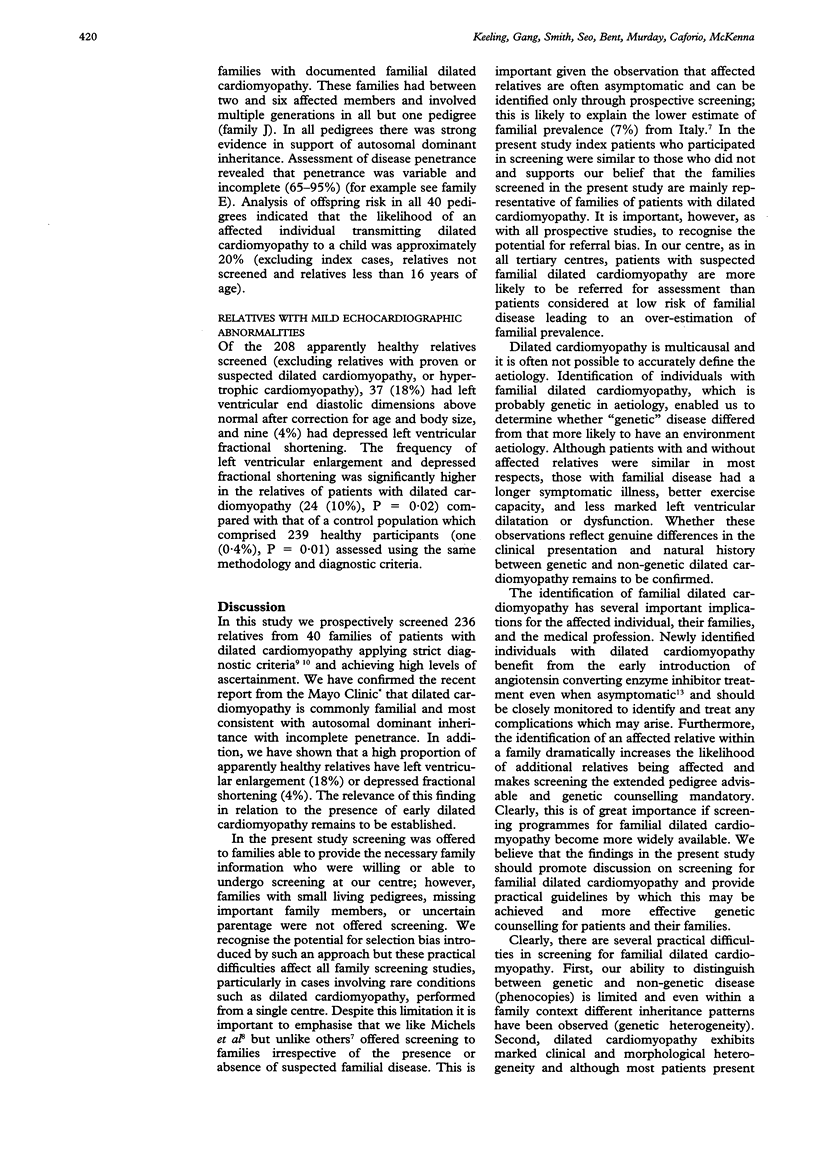
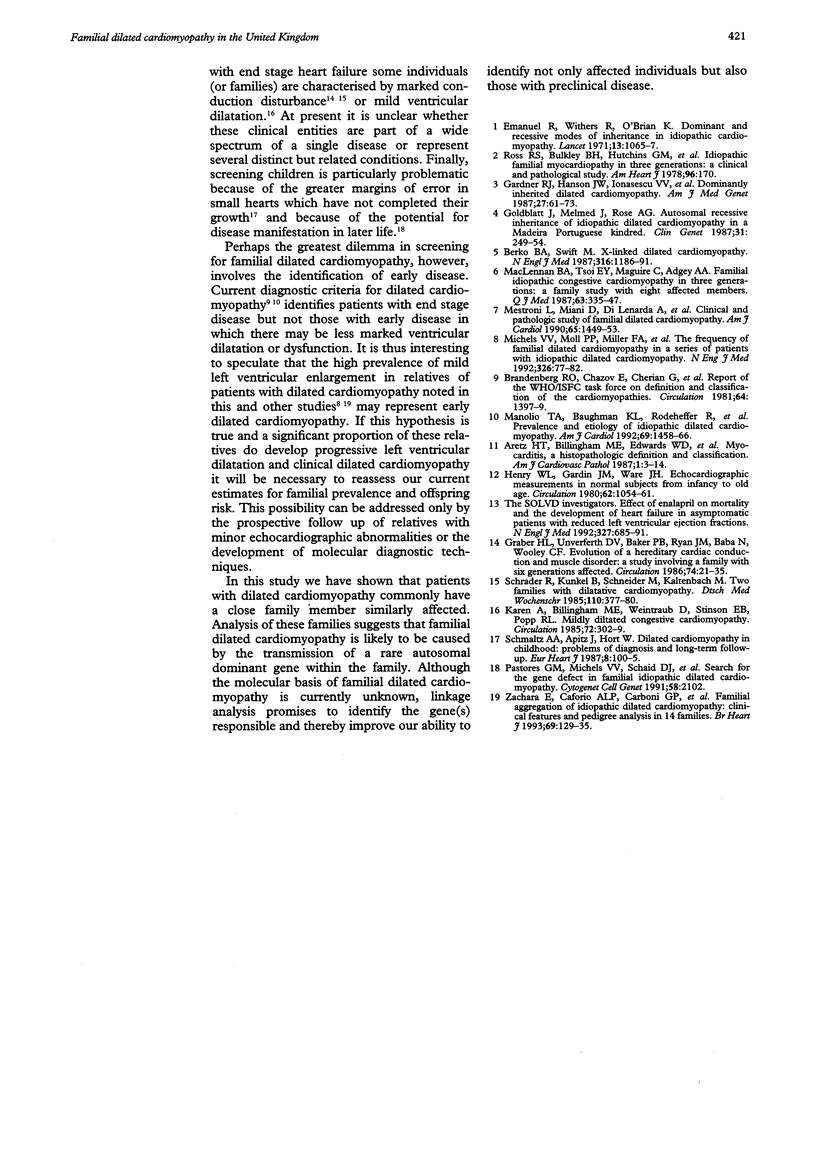
Selected References
These references are in PubMed. This may not be the complete list of references from this article.
- Aretz H. T., Billingham M. E., Edwards W. D., Factor S. M., Fallon J. T., Fenoglio J. J., Jr, Olsen E. G., Schoen F. J. Myocarditis. A histopathologic definition and classification. Am J Cardiovasc Pathol. 1987 Jan;1(1):3–14. [PubMed] [Google Scholar]
- Berko B. A., Swift M. X-linked dilated cardiomyopathy. N Engl J Med. 1987 May 7;316(19):1186–1191. doi: 10.1056/NEJM198705073161904. [DOI] [PubMed] [Google Scholar]
- Emanuel R., Withers R., O'Brien K. Dominant and recessive modes of inheritance in idiopathic cardiomyopathy. Lancet. 1971 Nov 13;2(7733):1065–1067. doi: 10.1016/s0140-6736(71)90383-7. [DOI] [PubMed] [Google Scholar]
- Gardner R. J., Hanson J. W., Ionasescu V. V., Ardinger H. H., Skorton D. J., Mahoney L. T., Hart M. N., Rose E. F., Smith W. L., Florentine M. S. Dominantly inherited dilated cardiomyopathy. Am J Med Genet. 1987 May;27(1):61–73. doi: 10.1002/ajmg.1320270108. [DOI] [PubMed] [Google Scholar]
- Goldblatt J., Melmed J., Rose A. G. Autosomal recessive inheritance of idiopathic dilated cardiomyopathy in a Madeira Portuguese kindred. Clin Genet. 1987 Apr;31(4):249–254. doi: 10.1111/j.1399-0004.1987.tb02803.x. [DOI] [PubMed] [Google Scholar]
- Graber H. L., Unverferth D. V., Baker P. B., Ryan J. M., Baba N., Wooley C. F. Evolution of a hereditary cardiac conduction and muscle disorder: a study involving a family with six generations affected. Circulation. 1986 Jul;74(1):21–35. doi: 10.1161/01.cir.74.1.21. [DOI] [PubMed] [Google Scholar]
- Henry W. L., Gardin J. M., Ware J. H. Echocardiographic measurements in normal subjects from infancy to old age. Circulation. 1980 Nov;62(5):1054–1061. doi: 10.1161/01.cir.62.5.1054. [DOI] [PubMed] [Google Scholar]
- Keren A., Billingham M. E., Weintraub D., Stinson E. B., Popp R. L. Mildly dilated congestive cardiomyopathy. Circulation. 1985 Aug;72(2):302–309. doi: 10.1161/01.cir.72.2.302. [DOI] [PubMed] [Google Scholar]
- MacLennan B. A., Tsoi E. Y., Maguire C., Adgey A. A. Familial idiopathic congestive cardiomyopathy in three generations: a family study with eight affected members. Q J Med. 1987 Apr;63(240):335–347. [PubMed] [Google Scholar]
- Manolio T. A., Baughman K. L., Rodeheffer R., Pearson T. A., Bristow J. D., Michels V. V., Abelmann W. H., Harlan W. R. Prevalence and etiology of idiopathic dilated cardiomyopathy (summary of a National Heart, Lung, and Blood Institute workshop. Am J Cardiol. 1992 Jun 1;69(17):1458–1466. doi: 10.1016/0002-9149(92)90901-a. [DOI] [PubMed] [Google Scholar]
- Mestroni L., Miani D., Di Lenarda A., Silvestri F., Bussani R., Filippi G., Camerini F. Clinical and pathologic study of familial dilated cardiomyopathy. Am J Cardiol. 1990 Jun 15;65(22):1449–1453. doi: 10.1016/0002-9149(90)91353-8. [DOI] [PubMed] [Google Scholar]
- Michels V. V., Moll P. P., Miller F. A., Tajik A. J., Chu J. S., Driscoll D. J., Burnett J. C., Rodeheffer R. J., Chesebro J. H., Tazelaar H. D. The frequency of familial dilated cardiomyopathy in a series of patients with idiopathic dilated cardiomyopathy. N Engl J Med. 1992 Jan 9;326(2):77–82. doi: 10.1056/NEJM199201093260201. [DOI] [PubMed] [Google Scholar]
- Ross R. S., Bulkley B. H., Hutchins G. M., Harshey J. S., Jones R. A., Kraus H., Liebman J., Thorne C. M., Weinberg S. B., Weech A. A. Idiopathic familial myocardiopathy in three generations: a clinical and pathologic study. Am Heart J. 1978 Aug;96(2):170–178. doi: 10.1016/0002-8703(78)90082-0. [DOI] [PubMed] [Google Scholar]
- Schmaltz A. A., Apitz J., Hort W. Dilated cardiomyopathy in childhood: problems of diagnosis and long-term follow-up. Eur Heart J. 1987 Feb;8(2):100–105. doi: 10.1093/oxfordjournals.eurheartj.a062236. [DOI] [PubMed] [Google Scholar]
- Schräder R., Kunkel B., Schneider M., Kaltenbach M. Zwei Familien mit dilatativer Kardiomyopathie. Dtsch Med Wochenschr. 1985 Mar 8;110(10):377–380. doi: 10.1055/s-2008-1068831. [DOI] [PubMed] [Google Scholar]
- Zachara E., Caforio A. L., Carboni G. P., Pellegrini A., Pompili A., Del Porto G., Sciarra A., Bosman C., Boldrini R., Prati P. L. Familial aggregation of idiopathic dilated cardiomyopathy: clinical features and pedigree analysis in 14 families. Br Heart J. 1993 Feb;69(2):129–135. doi: 10.1136/hrt.69.2.129. [DOI] [PMC free article] [PubMed] [Google Scholar]


